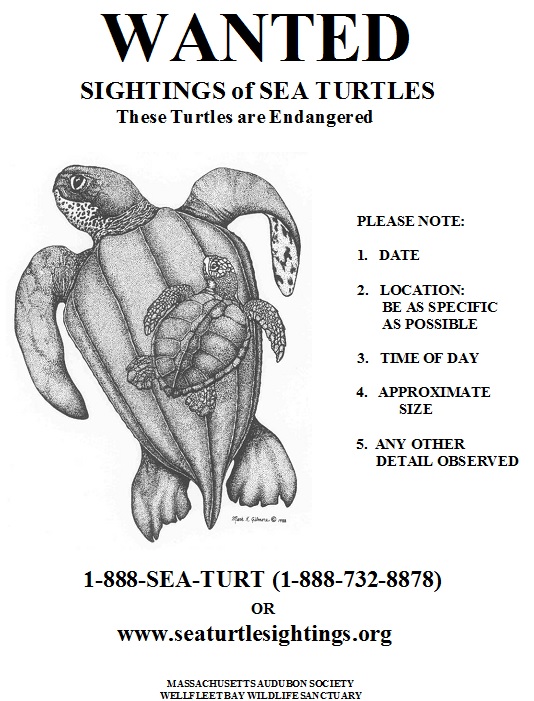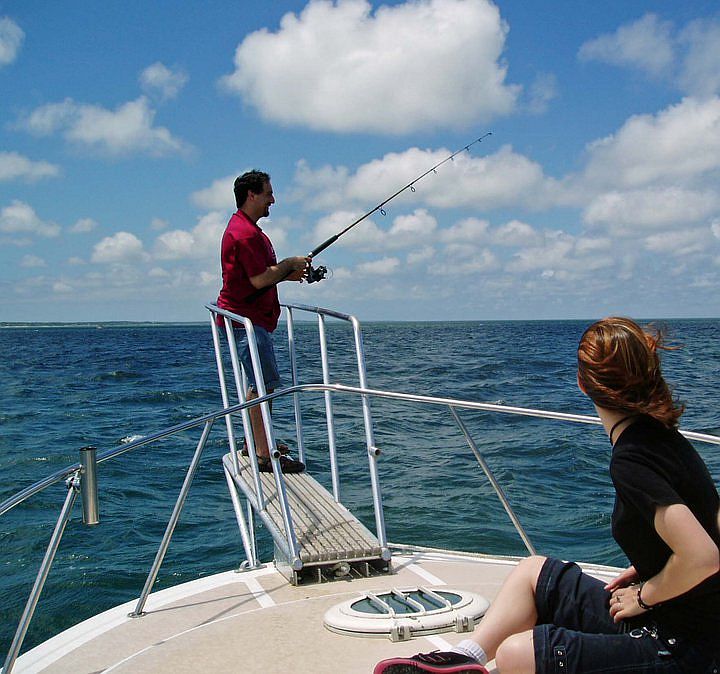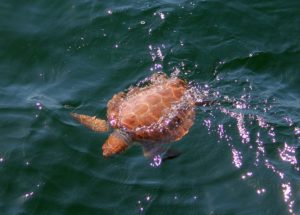“I’ve fished these waters for 40 years and have never seen a sea turtle before!”
 This reaction is not unusual from boaters who report sightings of live sea turtles during the spring and summer, and we are eagerly awaiting the first 2016 report of a live turtle off Massachusetts.
This reaction is not unusual from boaters who report sightings of live sea turtles during the spring and summer, and we are eagerly awaiting the first 2016 report of a live turtle off Massachusetts.
Mass Audubon’s Wellfleet Bay Wildlife Sanctuary has operated a Sea Turtle Sighting Hotline for Boaters since 2002. The hotline has two primary goals: to collect information about where and when sea turtles feed in New England waters, and to alert New England boaters that sea turtles may be seen in the late spring, summer and fall, in hopes that awareness of the turtles’ presence will result in boaters being more vigilant about avoiding boat strikes.
Boaters can report sea turtle sightings online (www.seaturtlesightings.org), or by phone
(1-888-SEA-TURT). And the website is smart phone-friendly. Last year, High Road Marketing and Communication, of Rochester, MA, donated an upgrade to the website, making it even easier to report sightings by smart phones or tablets. Each year we ask volunteers to help distribute hotline fliers to marinas, yacht clubs, harbormasters, bait and tackle stores, town bulletin boards and other locations along the Massachusetts coast. We also advertise in the recreational fishing magazine, “On The Water”.

Recreational boaters often are in the best position to see sea turtles (photo courtesy of Old School Charters)
When boaters report sea turtle sightings, they are asked to provide date, location, time, approximate size, color and any other observations. When reporting parties include their phone number, they will receive a call from a hotline staff member to discuss the sighting. Reporting parties frequently take advantage of this option, and staff enjoy answering questions about sea turtles and hearing boaters’/fishermen’s stories. People are often very enthusiastic about their sightings, and we feel that this personal feedback generates interest and awareness.
Four types of sea turtles swim and feed in our waters:
- Leatherbacks, which can reach eight or ten feet long and can weigh up to 1,500 pounds, sometimes resemble an overturned dinghy in size and appearance
- Loggerheads, primarily juveniles in our waters, which average 25 – 75 pounds, are 1 ½ to 2 ft. long and appear brown with areas of orange and yellow
- Green sea turtles (juveniles) and Kemp’s ridleys (juveniles), range in length from about 12 – 20 inches. Greens appear mottled, brown or mud-colored, and Kemp’s ridleys are dark gray, the color of wet cement with white around the head and mouth.

Loggerhead sea turtle (photo by Amy Warren).
Sea turtles spend most of their time underwater, but sometimes can be seen basking, swimming or feeding at the surface, where they are vulnerable to boat strikes. Refer to our website, www.seaturtlesightings.org for more detailed descriptions, photos and sighting maps.
The Mass Audubon boaters’ hotline is designed for sightings of free-swimming sea turtles. Reporting parties are instructed, either by recorded phone message or online, that if the turtle is injured or entangled and needs immediate assistance, he/she should call the Center for Coastal Studies’ hotline (1-800-900-3622) and stand by, if possible, to help the responders locate the distressed turtle.
Although the boaters’ hotline sightings do not reflect accurate counts, there is some indication that the number of live sightings of hard shelled sea turtles (loggerhead, green and Kemp’s ridley) from late spring, summer and fall can help predict the magnitude of cold-stunning events that have become an annual phenomenon in late fall and early winter on the Cape.
The earliest live sea turtle sighting we’ve ever received was a very detailed report of a loggerhead on April 22, 2012, off the Chatham fish pier. So if you’re a boater, maybe this will be your summer to see a sea turtle out on the water. Watch for them, keep search images in mind, and please report any sightings.
Our thanks to Sea Turtle Hotline coordinator Karen Dourdeville for this post.

